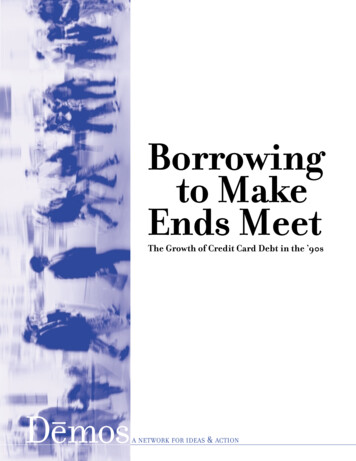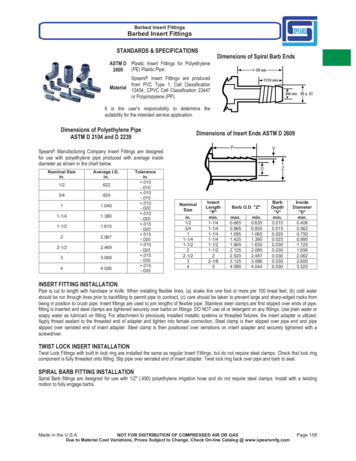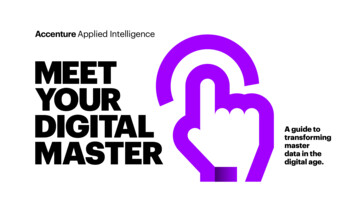
Transcription
Borrowingto MakeEnds MeetThe Growth of Credit Card Debt in the ’90sDemosA NETWORK FOR IDEAS& ACTION
–DemosBoard of TrusteesStephen Heintz, Board ChairRockefeller Brothers FundArnie MillerIssacson MillerTom CampbellHaas School of Business,University of California, BerkeleyWendy PuriefoyPublic Education NetworkMiles RapoportPresident, De-mosJuan FigueroaAnthem FoundationDavid SkaggsCenter for Democracyand CitizenshipRobert FranklinEmory UniversityCharles HalpernVisiting Scholar,University of California LawSchool, BerkeleyEric LiuAuthor and EducatorLinda Tarr-WhelanTarr-Whelan and AssociatesErnest TollersonNew York City PartnershipRuth WoodenPublic AgendaAffiliations are listed for identification purposes only.De-mosA NETWORK FOR IDEAS&ACTION-mos is a non-partisan, non-profit public policy researchDeand advocacy organization based in New York City. We arecommitted to a long-term effort to reframe and redesignpolicy and politics to meet the complex challenges of the21st century. We seek to bring everyone into the life ofAmerican democracy and to achieve a broadly shared prosperitycharacterized by greater opportunity and less disparity.
Borrowingto MakeEnds MeetThe Growth of Credit Card Debt in the ’90sTamara DrautDirector, Economic Opportunity ProgramJavier SilvaSenior Policy and Research AssociateDemosA NETWORK FOR IDEAS& ACTION
AcknowledgmentsThe authors would like to thank the following people fortheir valuable comments and assistance with this report:Heather Boushey, Center for Economic and Policy ResearchSteve Brobeck, Consumer Federation of AmericaJohn Farris, North Carolina Self-Help Credit UnionJean Ann Fox, Consumer Federation of AmericaJeanne Hogarth, Program Manager, Federal Reserve BoardRobert Manning, Professor, Rochester University, andauthor of Credit Card NationSusan Wieler, ConsultantA special thank you to Mark Lindeman, Assistant Professorof Political Science at Bard College, for collecting and calculating the data used in this report from the Survey ofConsumer Finances.This research was funded in part by the Annie E. CaseyFoundation and the Fannie Mae Foundation. We thankthem for their support and acknowledge that the findingsand conclusions presented in this report are those of theauthors alone, and do not necessarily reflect the opinionsof these foundations.The views expressed in this report do not necessarily reflectthe views of the De–mos Board of Trustees. September 2003 De–mos: A Network for Ideas and ActionDe–mos: A Network for Ideas and Action220 Fifth Avenue, 5th FloorNew York, NY 10001212-633-1405212-633-2015www.demos-usa.org4B o r r o w i n g t o M a k e E n d s M e e t : T h e G r o w t h of C r e d i t C a r d D e b t i n t h e ’9 0 s
ContentsPreface7Executive Summary9I. IntroductionII. Rising Credit Card Debt 1989–2001All FamiliesBy Income ClassBy Race/EthnicityAmong Older Americans1719III. Possible Factors Driving DebtStagnant IncomesJob DisplacementUnderemploymentHealth Care CostsHousing Costs27IV. The Effects of Deregulation on Industry PracticesThe Dismantling of Usury LawsCard Companies Take Advantage of Deregulated Interest RatesSoaring Penalty FeesAggressive Marketing and Credit Line ExpansionLow Minimum Payment Requirements33V. Policy RecommendationsIndustry Side ApproachesConsumer Side ApproachesAppendixA. MethodologyB. Statistics and Trends of Credit Card Debtby Household Income QuintileC. Credit Card Debt Personal Stories39444648References59Notes61-m o s : A N e t w o r k fo r I d e a s & A c t i o nDe5
PrefaceAt the close of the 1990s, against the backdrop of the economic boom, many low- andmoderate-income families were struggling financially and taking on credit card debt atrates unprecedented in American history. There is growing evidence that a combinationof structural and economic trends coupled with abusive credit card industry practices leftworking families with few options other than to borrow heavily during the ’90s to makeends meet. As poverty and severe economic inequality continue to be pervasive, high creditcard debt will only serve to exacerbate this growing trend.However, there are larger implications facing families beyond their ability to servicehigh credit card debt. This debt severely compromises entry into the middle class throughthe purchase of an asset—primarily a first home—as so many Americans have in previousgenerations, as more and more resources are diverted to high-interest credit card payments. Access to low-cost financial services and credit, particularly in economically distressed communities, is uncommon, relegating these communities to substandard financialservices. High credit card debt also threatens middle-income families who have alreadyachieved the American dream. In many cases, these working families are one paycheckfrom financial disaster.The report analyzes several years of data from the Federal Reserve Board’s Survey ofConsumer Finances: 1989, 1992, 1995, 1998, and 2001. The report frames the findingswithin the context of structural and economic trends as well as credit card industry practices. The report prescribes a set of policy options which begin to address industry practices as well as the growing economic insecurity facing Americans.This study is the first report in a series examining the relationship between credit carddebt and economic security conducted by the Economic Opportunity Program at De–mos.This study was undertaken as part of De–mos’s ongoing efforts to focus new public and political attention on the challenge of providing greater economic opportunity and security forAmericans in the 21st century. De–mos will work with policymakers and advocates to promotepolicy solutions to address the growth of debt and curb excessive industry practices. De–mos’sother major area of work, democracy reform, reflects our view that addressing this and otherurgent national problems requires broader participation by all Americans.Miles RapoportPresidentTamara DrautDirector, Economic Opportunity Program-m o s : A N e t w o r k fo r I d e a s & A c t i o nDe7
4,126Average credit card debt foran American family in 2001Executive SummaryThe mid and late 1990s will always be remembered as an era of unprecedented prosperity.But for most American families, the roaring ’90s had a dark underbelly—it was also theDecade of Debt.Between 1989 and 2001, credit card debt in America almost tripled, from 238 billionto 692 billion. The savings rate steadily declined, and the number of people filing forbankruptcy jumped 125 percent.How did the average family fare? During the 1990s, the average American familyexperienced a 53 percent increase in credit card debt, from 2,697 to 4,126 (all figuresmeasured in 2001 dollars). Low-income families saw the largest increase—a 184 percentrise in their debt—but even very high-income families had 28 percent more credit card debt in 2001than they did in 1989.Credit card debt is often dismissed as theAverage credit card debt foran American family in 1989consequence of frivolous consumption. But anexamination of broad structural and economictrends during the 1990s—including stagnant or declining real wages, job displacement,and rising health care and housing costs—suggests that many Americans are using creditcards as a way to fill a growing gap between household earnings and the costs of essentialgoods and services. Usurious practices in the credit cardindustry, in the form of high rates and fees, have taken advanDuring the 1990s, the averagetage of the increased need for credit. As a result, a growingAmerican family’s credit cardnumber of American families find themselves perpetuallydebt rose by 53 percent.indebted to the credit card industry, which—despite claimsof losses and chargeoffs—remains one of the most profitablesectors of the banking industry. 2,697-m o s : A N e t w o r k fo r I d e a s & A c t i o nDe9
key findingsAverage Credit Card Debt Increased by 53 Percent. American families in all income groupsrapidly accumulated credit card debt in the 1990s. According to 2001 data from the Surveyof Consumer Finances, 76 percent of American families hold credit cards, 55 percent ofthose with cards carry debt, and the average amount of debt is 4,126.Average Debt of American Families, by Income RangeFamily income groupAll families 10,000 10,000– 24,999 25,000– 49,999 50,000– 99,999 100,000 or moreFamilies holdingcredit cardsin 2001Cardholdingfamiliesreporting debtin it carddebt in 2001 ��200153%18442467528De–mos’s calculations from the Survey of Consumer Finances, 1989, 1992, 1995, 1998 and 2001.As the previous table shows, between 1989 and 2001: Credit card debt among very low-income families grew by an astonishing 184percent. But middle-class families were also hit hard—their credit card debt roseby 75 percent. Very low-income families are most likely to be in credit card debt: 67 percent ofcardholding families with incomes below 10,000 are affected. Moderate-incomefamilies are not far behind: 62 percent of families earning between 25,000 and 50,000 suffer from credit card debt.It is important to note that these figures may be substantially underreported. Theabsolute figures (for example, 4,126 of average debt) are based on data that consumersreported about themselves in surveys. Aggregate data on outstanding revolving credit reportedby the Federal Reserve puts the average credit card debt per household at about 12,000—nearly three times more than the self-reported amount. Although the survey figures mayunderestimate the severity of credit card debt, they can be compared accurately from yearto year, showing us a clear trend: debt skyrocketed for all income groups in the last decade.10B o r r o w i n g t o M a k e E n d s M e e t : T h e G r o w t h of C r e d i t C a r d D e b t i n t h e ’ 9 0 s
It should be noted that while debt substantially increased between 1989 and 2001,average credit card debt fell between 1998 and 2001 for all income groups. Preliminaryresearch and data suggests a portion of credit card debt was transferred using cash-outrefinancing, home equity loans, and credit lines—taking advantage of 40-year lows oninterest rates during this period. Other factors contributing to the decrease in credit carddebt, which is mostly observed in families with incomes less than 50,000, are low unemployment rates and increases in wages during the 1998 to 2001 time period.However, the declining trend in credit card debt between 1998 and 2001 should beobserved with caution, due to the lingering recession that began in March 2001 and thecontinued rise in unemployment rates.Average Credit Card Debt in the 1990s 5,000 4,486 4,126 4,000 3,454 3,000 2,991 2,697 2,00019891992199519982001De–mos’s calculations from the Survey of Consumer Finances, 1989, 1992, 1995, 1998 and 2001.Average Debt by Race/Ethnicity. Though they may be less likely to have credit cards, the blackand Hispanic families who do use them are more likely to have credit card debt than whitefamilies. The higher reliance on credit cards among black and Hispanic families may reflectthe lower than average incomes, savings, and wealth among these groups.Race/EthnicityAll familiesWhite familiesBlack familiesHispanic familiesPercent holdingcredit cardsin 2001Cardholdingpercentreporting debtin 200176%82595355%518475Averagecredit carddebt in 2001 4,1264,3812,9503,691De–mos’s calculations using 2001 Survey of Consumer Finances.-m o s : A N e t w o r k fo r I d e a s & A c t i o nDe11
what’s driving the rise in debt?Families with credit card debt are often thought to be shortsighted or ill disciplined, guiltyof “living beyond their means.” While materialistic pressures or desires are part of thestory, major trends in wages, housing costs and health care costs strongly suggest thatstructural economic factors helped fuel the Decade of Debt.As the data below indicate, the 1990s saw health care and housing costs rise for manysegments of the population, while real wages stayed flat or decreased.Health Care. Health care premiums consistently increased over the decade. Between1989 and 1990 alone, they jumped 18 percent;between 2000 and 2001, they jumped another11 percent. In addition, the proportion of individuals whose employers paid the full costsof health coverage fell significantly.Housing Crisis Increased6millions of working familiesHousing Costs. The number of working families with severe housing burdens—thosespending more than 50 percent of theirincome on housing—grew dramatically inthe late ’90s. From 1997 to 2001, that numberincreased by nearly 60 percent, jumpingfrom 3 million to nearly 5 million workingfamilies (see graph at right).4.843.83.020199719992001Source: America’s Working Families and the Housing LandscapeReal Income. Real incomes for low- and moderate-income families were stagnant ordeclining. Family incomes for the bottom 40 percent of the income distribution finallyrose in the last half of the 1990s, but quickly declined between 2000 and 2001 with theonset of the recession.Although more research would be needed to establish a causal relationship betweenthese trends and the concurrent rise in credit card debt, the preliminary data suggesta meaningful association.Average40th Percentile20th PercentileReal Family Income by Income Group 67,609Real income, in thousands of dollars 70k 66,863 60k 50k 57,221 59,234 41,980 40k 38,601 30k 20k 24,670 22,062 21,997 24,000 10k 019891995Source: State of Working America, 200212 41,127 38,047B o r r o w i n g t o M a k e E n d s M e e t : T h e G r o w t h of C r e d i t C a r d D e b t i n t h e ’9 0 s2000 2001
industry practices in an unregulated marketSince the late 1970s, America’s credit card industry has enjoyed a period of steady deregulation. Two Supreme Court rulings, the first in 1978 and the second in 1996, effectivelyhobbled state usury laws that protected consumers from excessively high interest rates andfees. The rulings allowed national banks to charge the highest interest rate permitted inthe bank’s home state—as opposed to the rate in the state where the customer resides.Taking advantage of this deregulatory climate, the credit card companies ushered ina wave of unscrupulous and excessive practices in the 1990s—all aimed at keeping consumers in debt. Some of these practices include:Aggressive Marketing. Direct mail solicitations jumped from 1.52 billion in 1993 to over 5billion in 2001.Relentless Credit Extension. Between 1993and 2000, the industry more than tripledthe amount of credit it offered to customers,from 777 billion to almost 3 trillion. Theaverage cardholding household now hassix credit cards with an average credit lineof 3,500 on each—for a total of 21,000in available credit.Amount of Time and Money It Takes toPay Off Debt at New “Monthly Minimum” RatesCredit card balance 5,000 5,000 8,000 8,000 10,000 10,000Interest rate15%1815181518Years topay off debtInterest cost324537523956 7,66513,53112,58122,26015,85728,079Lowering of Minimum PaymentRequirements. Minimum payment requireMost credit cards assume a minimum payment of 2 percent of the balance or 10, whicheverments—the amount of their balance cusis higher. Source: De–mos’s calculations.tomers can pay without incurring apenalty—dropped from 5 percent to only 2or 3 percent, making it easier for consumers to carry more debt. Assuming an interest rateof 15 percent, it would now take more than 30 years to pay off a credit card balance of 5,000by making the minimum payment.Skyrocketing Late Fees and Penalties. Late fees have become the fastest growing source ofrevenue for the industry, jumping from 1.7 billion in 1996 to 7.3 billion in 2001. Latefees now average 29, and most cards have reduced the late payment grace period from14 days to 0 days. In addition to charging late fees, the major card companies use the firstlate payment as an excuse to cancel low, introductory rates—often making a zero percentcard jump to between 22 and 29 percent.The credit card industry’s punitive practices have paid off. Despite the industry’scomplaints about sharp increases in delinquencies and charge-offs, credit cards are continually one of the most profitable sectors in the banking industry. Pretax return on assets,a key measure of profitability, averaged 4.2 percent in 2002, the highest level since 1988.-m o s : A N e t w o r k fo r I d e a s & A c t i o nDe13
a starting point for policy changeNew legislation is needed to protect consumers from abusive industry practices, includingexcessive interest rates and fees. Additionally, it is important that policymakers acknowledge the growing economic insecurity facing low- and moderate-income families byaddressing the lack of savings and assets, low or stagnant wage growth, rising unemployment and soaring housing and health care costs. The following policy recommendationsare aimed at jumpstarting a conversation with policymakers, economic security advocatesand asset building organizations.Addressing Industry Practices Enacting a National Usury Law Regulating Late Payment Policies Increasing the Minimum Payment Requirement Improving Disclosure of Cardmember TermsExpanding Asset Building and Access to Credit Scaling up Individual Development Accounts Increasing Access to Alternative Forms of Short-term Credit Expanding Financial Literacy EducationAddressing Economic Insecurity Maintaining Bankruptcy Laws for Families in Severe Economic Distress Closing the Gap between Earnings and Costs: Increasing the Minimum Wage Bolstering Unemployment Insurance Expanding Health Insurance Coverage andAccess to Quality Early Childhood Education and CareconclusionThe growth of credit card debt, particularly among low- and moderate-income families, is atroubling indicator of economic disparity in this country. To cope with rising costs, stagnantincomes and a porous safety net, there is evidence that many families are using their creditcards to meet their basic economic needs. As unemployment continues to rise and communitiesgrapple with historic budget deficits by cutting funding for essential services, we can expectmore and more families to rely on this wealth-draining form of short-term credit.14B o r r o w i n g t o M a k e E n d s M e e t : T h e G r o w t h of C r e d i t C a r d D e b t i n t h e ’ 9 0 s
p e rs o na l storyJulie and Jerry Pickett, Struggling Midwestern Parentsn the surface, the Picketts have everything a middle-class sional tools to lifelines. “I bought everything on them, you know,family could want—three healthy kids, a house in suburban groceries, clothes for the kids, gas, everything,” Julie says.Middletown, Ohio, a strong network of friends and family, andAfter a few years of mounting debt, the Picketts had anothertwo small businesses of their own.child, which kept Julie’s hands full at home. They struggled toBut under that rosy surface, a financial timebomb threatens take care of their family on Jerry’s mid-range but seasonal salary.to wipe them out. The Picketts are being crushed by 40,000 Unable to afford private health care, they enrolled in Medicaid.in credit card debt, though they only have a combined yearlyAs soon as the kids started school, Julie went back to worksalary of about 45,000.at her own small retail business. Even with the extra incomeJulie and Jerry haven’t always been in such financial straits. they could not pay the bills. They began missing their minimumWhen they married ten years ago, they both earned modest livings, monthly credit card payments. “That’s when our debt beganshe in the retail business and he as the owner of a small to spiral out of control,” Julie says. “The situation began to getplumbing and heating company. Thoughscarier and scarier.”they used their credit cards often, they “I’m still paying forThat fear is compounded by threatsrarely missed a payment and floated manfromtheir creditors. Debt collectors—gr
experienced a 53 percent increase in credit card debt, from 2,697 to 4,126 (all figures measured in 2001 dollars). Low-income families saw the largest increase—a 184 percent rise in their debt—but even very high-income fam-ilies had 28 percent more credit card debt in 2001 than they did in 1989. Cr











